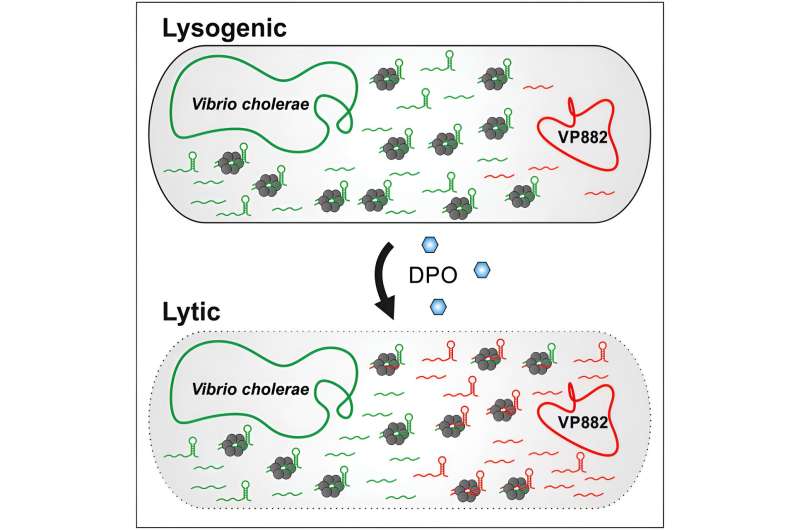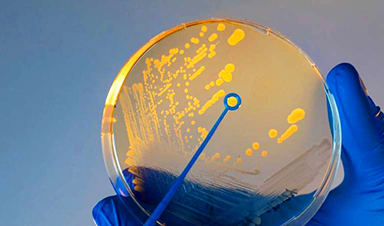Viruses need hosts. Whether it’s measles, the flu or coronavirus, viral pathogens cannot multiply or infect other organisms without the assistance of their hosts’ cellular infrastructure. However, humans are not the only ones affected by viruses: animals, plants and even microorganisms can all serve as hosts.
Viruses that use bacteria as host cells are called bacteriophages (or simply “phages” for short) and are thought to be the most abundant biological entities of all. Just as the human immune system springs into action to resist a flu or coronavirus infection, bacteria do not simply allow phages to infiltrate their cellular machinery without a fight.
A research team at the University of Jena and its Cluster of Excellence “Balance of the Microverse” has examined in detail the complex interaction of attack and defense strategies when cholera-causing bacteria (Vibrio cholerae) are infected with a bacteriophage known as VP882—and discovered that tiny RNA molecules play a decisive role. The researchers’ findings have been published in the latest issue of the journal Cell Host & Microbe.
From harmless housemate to cunning kidnapper
There are two ways in which phages can multiply after infecting bacteria: either as invisible passengers, hidden in the bacteria’s genetic material, or as cunning kidnappers, multiplying in vast numbers in bacterial cells without regard for potential losses and, ultimately, destroying the cells. Which method a phage adopts depends on whether sufficient numbers of other host cells are available in the immediate environment to provide shelter.
But how do phages determine this? “They rely on a chemical counting mechanism that bacteria use to identify other members of their species,” explains Prof. Dr. Kai Papenfort of the University of Jena, who headed up the project.
Known as “quorum sensing,” this method uses signal molecules that are produced by bacteria and released into their surroundings. At the same time, the bacteria monitor the concentration of these molecules using specific receptors, thereby gaining information about the size of their current population.
“The phages’ trick essentially involves ‘listening in’ to this chemical communication between bacteria,” says Papenfort.

In their experiments, the Jena researchers examined what happens to the phages and bacteria once the bacteria emit their quorum sensing signals. “We have observed that 99% of bacteria are destroyed within 60 minutes, in which time the phages take control,” reports Dr. Marcel Sprenger, the lead author of the article.
The team discovered that this switchover is controlled by tiny RNA molecules, one of which is called “VpdS” (VP882 phage-derived sRNA). “As soon as the phages receive the chemical signal from the bacteria, this RNA is produced in high quantities,” says Sprenger.
How bacteria fight back against viruses
In order to find out precisely which genes are regulated by VpdS, the team adopted a comprehensive, technological approach and infected bacteria cultures with both VP882 phages and genetically modified phages unable to produce VpdS.
Applying a method known as “RNA interaction by ligation and sequencing,” the researchers were able to identify the interactions between all RNA molecules in the bacteria cultures at different times. “This not only gave us insights into which genes are active, it also showed how they interact,” says Papenfort.
This method enabled the researchers to examine the genes of the phages as well as those of the host bacteria. As a result, the researchers gained extensive insights into the changes that occurred both during and after quorum sensing. “We were able to demonstrate that VpdS regulates phage genes as well as genes of the host, which effectively explains the destruction of bacterial cells,” says Papenfort.
However, the researchers have been able to deduce further relationships from the data they collected. For example, bacteria also have genes that, when activated by a chemical signal, fight back against the phages’ propagation and thereby counteract their own destruction.
According to Papenfort, this aspect is particularly interesting. “We can see these as the precursors to the immune systems in higher organisms. Bacteria have many genes that protect them against viruses.” Given that these genes are also present in higher organisms, the researchers surmise that RNA molecules could also play an important role in their regulation.
More information: Small RNAs direct attack and defence mechanisms in a quorum sensing phage and its host, Cell Host & Microbe (2024). DOI: 10.1016/j.chom.2024.03.010. www.cell.com/cell-host-microbe … 1931-3128(24)00090-8
Journal information: Cell Host & Microbe
News
Scientists Melt Cancer’s Hidden “Power Hubs” and Stop Tumor Growth
Researchers discovered that in a rare kidney cancer, RNA builds droplet-like hubs that act as growth control centers inside tumor cells. By engineering a molecular switch to dissolve these hubs, they were able to halt cancer [...]
Platelet-inspired nanoparticles could improve treatment of inflammatory diseases
Scientists have developed platelet-inspired nanoparticles that deliver anti-inflammatory drugs directly to brain-computer interface implants, doubling their effectiveness. Scientists have found a way to improve the performance of brain-computer interface (BCI) electrodes by delivering anti-inflammatory drugs directly [...]
After 150 years, a new chapter in cancer therapy is finally beginning
For decades, researchers have been looking for ways to destroy cancer cells in a targeted manner without further weakening the body. But for many patients whose immune system is severely impaired by chemotherapy or radiation, [...]
Older chemical libraries show promise for fighting resistant strains of COVID-19 virus
SARS‑CoV‑2, the virus that causes COVID-19, continues to mutate, with some newer strains becoming less responsive to current antiviral treatments like Paxlovid. Now, University of California San Diego scientists and an international team of [...]
Lower doses of immunotherapy for skin cancer give better results, study suggests
According to a new study, lower doses of approved immunotherapy for malignant melanoma can give better results against tumors, while reducing side effects. This is reported by researchers at Karolinska Institutet in the Journal of the National [...]
Researchers highlight five pathways through which microplastics can harm the brain
Microplastics could be fueling neurodegenerative diseases like Alzheimer's and Parkinson's, with a new study highlighting five ways microplastics can trigger inflammation and damage in the brain. More than 57 million people live with dementia, [...]
Tiny Metal Nanodots Obliterate Cancer Cells While Largely Sparing Healthy Tissue
Scientists have developed tiny metal-oxide particles that push cancer cells past their stress limits while sparing healthy tissue. An international team led by RMIT University has developed tiny particles called nanodots, crafted from a metallic compound, [...]
Gold Nanoclusters Could Supercharge Quantum Computers
Researchers found that gold “super atoms” can behave like the atoms in top-tier quantum systems—only far easier to scale. These tiny clusters can be customized at the molecular level, offering a powerful, tunable foundation [...]
A single shot of HPV vaccine may be enough to fight cervical cancer, study finds
WASHINGTON -- A single HPV vaccination appears just as effective as two doses at preventing the viral infection that causes cervical cancer, researchers reported Wednesday. HPV, or human papillomavirus, is very common and spread [...]
New technique overcomes technological barrier in 3D brain imaging
Scientists at the Swiss Light Source SLS have succeeded in mapping a piece of brain tissue in 3D at unprecedented resolution using X-rays, non-destructively. The breakthrough overcomes a long-standing technological barrier that had limited [...]
Scientists Uncover Hidden Blood Pattern in Long COVID
Researchers found persistent microclot and NET structures in Long COVID blood that may explain long-lasting symptoms. Researchers examining Long COVID have identified a structural connection between circulating microclots and neutrophil extracellular traps (NETs). The [...]
This Cellular Trick Helps Cancer Spread, but Could Also Stop It
Groups of normal cbiells can sense far into their surroundings, helping explain cancer cell migration. Understanding this ability could lead to new ways to limit tumor spread. The tale of the princess and the [...]
New mRNA therapy targets drug-resistant pneumonia
Bacteria that multiply on surfaces are a major headache in health care when they gain a foothold on, for example, implants or in catheters. Researchers at Chalmers University of Technology in Sweden have found [...]
Current Heart Health Guidelines Are Failing To Catch a Deadly Genetic Killer
New research reveals that standard screening misses most people with a common inherited cholesterol disorder. A Mayo Clinic study reports that current genetic screening guidelines overlook most people who have familial hypercholesterolemia, an inherited disorder that [...]
Scientists Identify the Evolutionary “Purpose” of Consciousness
Summary: Researchers at Ruhr University Bochum explore why consciousness evolved and why different species developed it in distinct ways. By comparing humans with birds, they show that complex awareness may arise through different neural architectures yet [...]
Novel mRNA therapy curbs antibiotic-resistant infections in preclinical lung models
Researchers at the Icahn School of Medicine at Mount Sinai and collaborators have reported early success with a novel mRNA-based therapy designed to combat antibiotic-resistant bacteria. The findings, published in Nature Biotechnology, show that in [...]





















